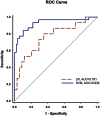Predicting postoperative vomiting among orthopedic patients receiving patient-controlled epidural analgesia using SVM and LR
- PMID: 27247165
- PMCID: PMC4887988
- DOI: 10.1038/srep27041
Predicting postoperative vomiting among orthopedic patients receiving patient-controlled epidural analgesia using SVM and LR
Erratum in
-
Corrigendum: Predicting postoperative vomiting among orthopedic patients receiving patient-controlled epidural analgesia using SVM and LR.Sci Rep. 2016 Jun 27;6:28408. doi: 10.1038/srep28408. Sci Rep. 2016. PMID: 27346482 Free PMC article. No abstract available.
Abstract
Patient-controlled epidural analgesia (PCEA) has been applied to reduce postoperative pain in orthopedic surgical patients. Unfortunately, PCEA is occasionally accompanied by nausea and vomiting. The logistic regression (LR) model is widely used to predict vomiting, and recently support vector machines (SVM), a supervised machine learning method, has been used for classification and prediction. Unlike our previous work which compared Artificial Neural Networks (ANNs) with LR, this study uses a SVM-based predictive model to identify patients with high risk of vomiting during PCEA and comparing results with those derived from the LR-based model. From January to March 2007, data from 195 patients undergoing PCEA following orthopedic surgery were applied to develop two predictive models. 75% of the data were randomly selected for training, while the remainder was used for testing to validate predictive performance. The area under curve (AUC) was measured using the Receiver Operating Characteristic curve (ROC). The area under ROC curves of LR and SVM models were 0.734 and 0.929, respectively. A computer-based predictive model can be used to identify those who are at high risk for vomiting after PCEA, allowing for patient-specific therapeutic intervention or the use of alternative analgesic methods.
Conflict of interest statement
The authors declare no competing financial interests.
Figures
References
-
- Lee S. Y., Hung C. J., Chen C. C. & Wu C. C. Survival analysis of postoperative nausea and vomiting in patients receiving patient-controlled epidural analgesia. J Chin Med Assoc: JCMA. 77(11), 589–93 (2014). - PubMed
-
- Scuderi P. E., James R. L., Harris L. & Mims G. R. 3rd. Antiemetic prophylaxis does not improve outcomes after outpatient surgery when compared to symptomatic treatment. Anesthesiology 90(2), 360–71 (1999). - PubMed
-
- Golembiewski J. & Tokumaru S. Pharmacological prophylaxis and management of adult postoperative/postdischarge nausea and vomiting. J Perianesth Nurs. 21(6), 385–97 (2006). - PubMed
-
- Kovac A. L. Prevention and treatment of postoperative nausea and vomiting. Drugs. 59(2), 213–43 (2000). - PubMed
Publication types
MeSH terms
Substances
LinkOut - more resources
Full Text Sources
Other Literature Sources


